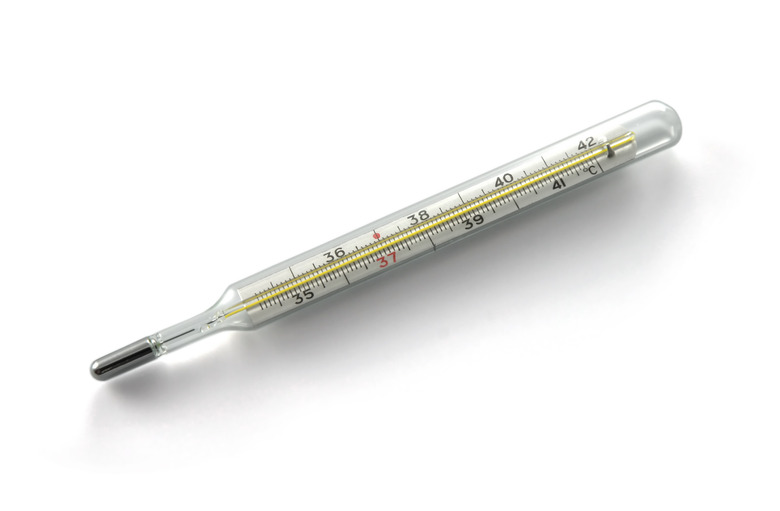Different Parts Of A Mercury Thermometer
Thermometers have myriad uses in science, engineering, industry, medical facilities and daily living. Thermometers come in several types, but the liquid-in-glass mercury thermometer is one of the most well-known. The operation of the mercury thermometer is simple to understand once all of the different parts are identified. The main parts of a mercury thermometer are the capillary, the bulb, the scale, and the expansion chamber.
Spherical Bulb
Spherical Bulb
The bulb is the lowest part of the thermometer, which has a spherical shape. This section of the thermometer acts as a reservoir to hold mercury — a silvery colored, heavy metal on the periodic table of elements. Mercury stays in liquid form when it is in an enclosed container, and maintained at room temperature. Like other liquids, metallic mercury expands in response to heat. If the temperature is sufficiently high, mercury in the bulb moves up the capillary.
Capillary Tube
Capillary Tube
The capillary of a mercury thermometer is the long cylindrical tube that is connected to the bulb. As temperature increases, mercury flows up the capillary. The further the mercury moves up the capillary, the higher the measured temperature. The capillary ends in a section known as the expansion chamber.
Expansion Chamber
Expansion Chamber
The expansion chamber of a mercury thermometer can be found at the top of the capillary. The function of the expansion chamber is to form a larger volume through which the mercury can fill if the maximum temperature scale is exceeded. It is undesirable for mercury to reach the expansion chamber since it means the thermometer is no longer sensitive to increases in temperature.
Scale Lines
Scale Lines
The scale is the series of lines that are etched into an area to the side of the capillary. The scale allows the temperature to be read off in units of degrees. The type of degree unit depends upon the specific thermometer. Two commonly used temperature scales, are degrees Celsius and degrees Fahrenheit, which are found on everyday thermometers. An alternative scale that measures temperature in degrees Kelvin is often used by scientists and engineers.
Safety Precautions
Safety Precautions
Careful handling of a mercury-in-glass thermometer is imperative for safety reasons. If the thermometer breaks open, the mercury in the bulb rolls out into little silver balls and toxic vapors are released into the air. When inhaled, the human nervous system can be harmed. Exposure to toxins must be quickly contained and minimized. If you break a mercury thermometer, a Poison Control Center or a healthcare professional can provide instructions on proper cleaning and disposal of mercury in your area. Even a tiny amount of mercury can pollute water and soil.
Cite This Article
MLA
Markings, Samuel. "Different Parts Of A Mercury Thermometer" sciencing.com, https://www.sciencing.com/different-parts-of-a-mercury-thermometer-12073649/. 26 June 2018.
APA
Markings, Samuel. (2018, June 26). Different Parts Of A Mercury Thermometer. sciencing.com. Retrieved from https://www.sciencing.com/different-parts-of-a-mercury-thermometer-12073649/
Chicago
Markings, Samuel. Different Parts Of A Mercury Thermometer last modified March 24, 2022. https://www.sciencing.com/different-parts-of-a-mercury-thermometer-12073649/
